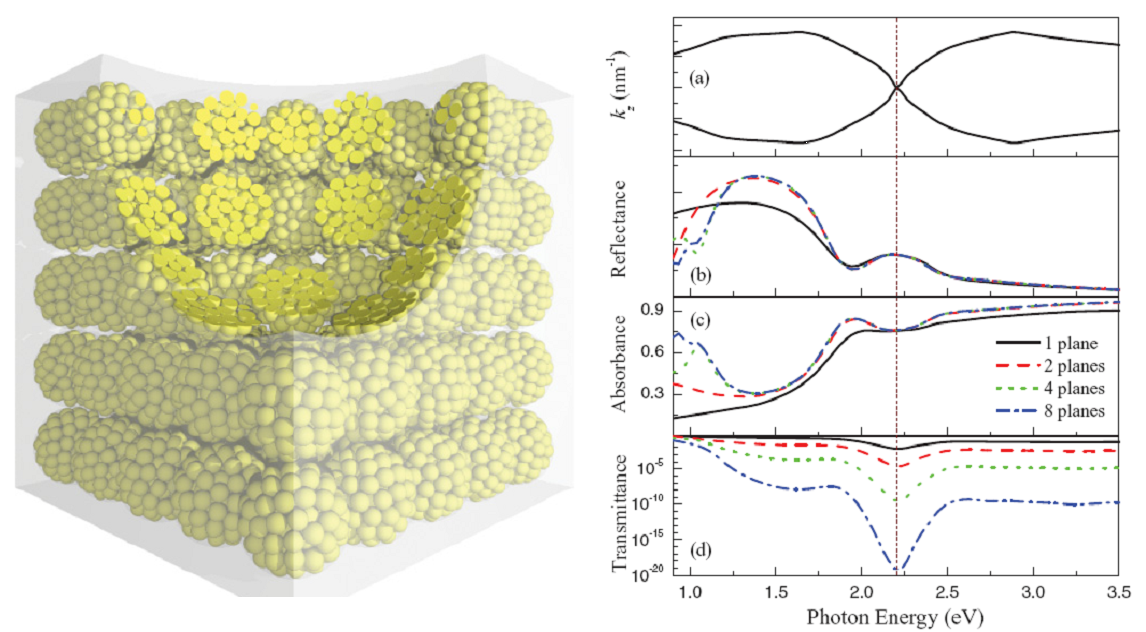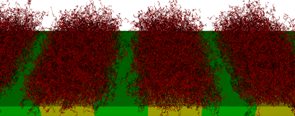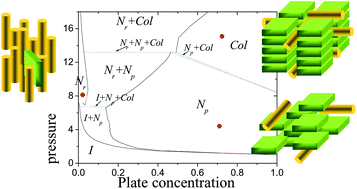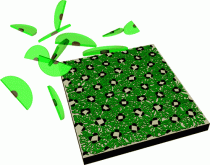 An international school on “Modeling and Computer Simulation Methods for Dendrimers” will be held in the University of Patras, Department of Materials Science from 12 to 15 December 2011
An international school on “Modeling and Computer Simulation Methods for Dendrimers” will be held in the University of Patras, Department of Materials Science from 12 to 15 December 2011
Updated information and program here
.
V. Yannopapas and A. Vanakaras, Phys. Rev. B., 84, 045128, (2011).
 We report on the emergence of a Dirac point in the dispersion relation of a plasmonic metamaterial. It is realized as a three-dimensional crystal (cubic or orthorhombic) whose lattice sites are decorated by aggregates of gold nanoparticles embedded in a high-index dielectric material. The Dirac-type dispersion lines of the photon modes are not a result of diffraction as in photonic crystals but due to subwavelength features and emerge from the gapless transition from a negative to a positive index band. The Dirac point is manifested as a dip in the spectrum of light transmittance through a finite slab of the metamaterial; however, transmittance does not decrease diffusively but exponentially due to the inherent losses of gold in the given spectral regime. ©2011 American Physical Society
We report on the emergence of a Dirac point in the dispersion relation of a plasmonic metamaterial. It is realized as a three-dimensional crystal (cubic or orthorhombic) whose lattice sites are decorated by aggregates of gold nanoparticles embedded in a high-index dielectric material. The Dirac-type dispersion lines of the photon modes are not a result of diffraction as in photonic crystals but due to subwavelength features and emerge from the gapless transition from a negative to a positive index band. The Dirac point is manifested as a dip in the spectrum of light transmittance through a finite slab of the metamaterial; however, transmittance does not decrease diffusively but exponentially due to the inherent losses of gold in the given spectral regime. ©2011 American Physical Society
URL: http://link.aps.org/doi/10.1103/PhysRevB.84.045128
DOI: 10.1103/PhysRevB.84.045128
| A. Koutsioubas and A. G. Vanakaras, Langmuir, 24 (23), 13717–13722 (2008). DOI: 10.1021/la802536v |
|
Abstract: Structural properties of polymer brushes tethered on a periodically nanopatterned substrate are investigated by computer simulations. The substrate consists of an alternating succession of two different types of equal-width parallel  stripes, and the polymers are end-tethered selectively on every second stripe. Three distinct morphologies of the nanopatterned brush have been identified, and their range of stability has been determined in terms of a single universal parameter that combines the grafting density, the polymer length, and the stripe width. We propose scaling relations for the average brush height and for the architectural properties of the outer surface of the nanopatterned brush under good solvent conditions. Our analysis provides guidelines for fabricating well-defined and tunable nanopatterned polymeric films. Copyright © 2008 American Chemical Society
stripes, and the polymers are end-tethered selectively on every second stripe. Three distinct morphologies of the nanopatterned brush have been identified, and their range of stability has been determined in terms of a single universal parameter that combines the grafting density, the polymer length, and the stripe width. We propose scaling relations for the average brush height and for the architectural properties of the outer surface of the nanopatterned brush under good solvent conditions. Our analysis provides guidelines for fabricating well-defined and tunable nanopatterned polymeric films. Copyright © 2008 American Chemical Society
S. D. Peroukidis, A. G. Vanakaras and D. J. Photinos, J. Mat. Chem., 20, 10495-10502, (2010).
 Abstract. A theoretical model of shape-anisometric particles embedded in a cubic lattice is formulated for binary mixtures combining rod-like, plate-like and spherical particles. The model aims at providing a tool for the prediction and interpretation of complex phase behavior in a variety of liquid crystalline colloids, biological and macromolecular systems. Introducing just repulsive interactions among the particles, a rich variety of phase structures and multiphasic equilibria is obtained, including isotropic, nematic, lamellar and columnar phases, demixing into phases of the same or different symmetries and structural microsegregation of the different species of the mixture within the same phase.
Abstract. A theoretical model of shape-anisometric particles embedded in a cubic lattice is formulated for binary mixtures combining rod-like, plate-like and spherical particles. The model aims at providing a tool for the prediction and interpretation of complex phase behavior in a variety of liquid crystalline colloids, biological and macromolecular systems. Introducing just repulsive interactions among the particles, a rich variety of phase structures and multiphasic equilibria is obtained, including isotropic, nematic, lamellar and columnar phases, demixing into phases of the same or different symmetries and structural microsegregation of the different species of the mixture within the same phase.
This article is part of the collection: Modelling of Materials (c) http://pubs.rsc.org | doi:10.1039/C0JM01692F
S. Droulias, A.G. Vanakaras, D.J. Photinos, Liquid Crystals, 37:6, 969-976, (2010).
Abstract: A theory of thermotropic nematic liquid crystals in which molecules form internally ordered clusters is presented. The formulation is based on the same m ean field approximation and form of the anisotropic potential used in the Maier-Saupe theory. A uniaxial nematic and two macroscopically isotropic phases are predicted. One of the isotropic phases consists of thermodynamically stable clusters with internal orientational order. The nematic phase shows cybotactic order throughout its range of stability. This order persists above the transition temperature, either as a stable feature or as a pretransitional effect. The values of the order parameter and of the entropy change at the nematic to isotropic phase transition depend on the size of the clusters. The Maier-Saupe theory is obtained in the limit of extremely large or extremely small clusters. URL: http://dx.doi.org/10.1080/02678292.2010.488819
ean field approximation and form of the anisotropic potential used in the Maier-Saupe theory. A uniaxial nematic and two macroscopically isotropic phases are predicted. One of the isotropic phases consists of thermodynamically stable clusters with internal orientational order. The nematic phase shows cybotactic order throughout its range of stability. This order persists above the transition temperature, either as a stable feature or as a pretransitional effect. The values of the order parameter and of the entropy change at the nematic to isotropic phase transition depend on the size of the clusters. The Maier-Saupe theory is obtained in the limit of extremely large or extremely small clusters. URL: http://dx.doi.org/10.1080/02678292.2010.488819
G.A. Tritsaris and A.G. Vanakaras,
; DOI: 10.1021/la904613j.
 Abstract: We demonstrate by computer experiments that the spontaneous formation of two-dimensional regularly patterned molecular networks containing voids may be an entirely entropy-driven process. On the basis of a simple model of core−(soft) shell half-disk-shaped particles, we show that, even without the mediation of any attractive interparticle forces, such particles self-organize to stable and macroscopically ordered patterns with regularly distributed voids. The morphology of these supramolecular porous motifs depends critically on the size of the core relative to the coronal halo. The reverse engineering analysis of these precise two-dimensional supramolecular porous templates suggests molecular-shape complementarity and polyphilicity as key design parameters for the bottom-up engineering of such functional substrates.
Abstract: We demonstrate by computer experiments that the spontaneous formation of two-dimensional regularly patterned molecular networks containing voids may be an entirely entropy-driven process. On the basis of a simple model of core−(soft) shell half-disk-shaped particles, we show that, even without the mediation of any attractive interparticle forces, such particles self-organize to stable and macroscopically ordered patterns with regularly distributed voids. The morphology of these supramolecular porous motifs depends critically on the size of the core relative to the coronal halo. The reverse engineering analysis of these precise two-dimensional supramolecular porous templates suggests molecular-shape complementarity and polyphilicity as key design parameters for the bottom-up engineering of such functional substrates.
, and .
P.K. Karahaliou, A.G. Vanakaras and D.J. Photinos, J. Chem. Phys., 131, 124516 (2009).
Abstract: The possible symmetries of the biaxial nematic phase are examined against the implications of the presently available experimental results. Contrary to the widespread notion that biaxial nematics have orthorhombic symmetry, our study shows that a monoclinic $$C_{2h}$$ symmetry is more likely to be the case for the recently observed phase biaxiality in thermotropic bent-core and calamitc tetrapode nematic systems. The methodology for differentiating between the possible symmetries of the biaxial nematic phase by NMR and by IR spectroscopy measurements is presented in detail. The manifestations of the different symmetries on the alignment of the biaxial phase are identified and their implications on the measurement and quantification of biaxiality as well as on the potential use of biaxial nematic liquid crystals in electro-optic applications are discussed. ©2009 American Institute of Physics
S.D. Peroukidis, P.K. Karahaliou, A.G. Vanakaras and D.J. Photinos, Liq. Cryst., 36(6), 727-737 (2009).
Abstract: We studied the symmetry and spatial uniformity of the orientational order of the biaxial nematic phase in the light of recent experimental observations of phase biaxiality in thermotropic bent-core and calamitic-tetramer nematics. Evidence is presented supporting monoclinic symmetry, instead of the usually assumed orthorhombic symmetry. The use of deuterium nuclear magnetic resonance to differentiate between the possible symmetries is described. The spatial aspects of biaxial order are presented in the context of the cluster model, wherein macroscopic biaxiality can result from the field-induced alignment of biaxial and possibly polar domains. The implications of different symmetries on the alignment of biaxial nematics and on the measurements of biaxial order are discussed in conjunction with the microdomain structure of the biaxial phase.
 An international school on “Modeling and Computer Simulation Methods for Dendrimers” will be held in the University of Patras, Department of Materials Science from 12 to 15 December 2011
An international school on “Modeling and Computer Simulation Methods for Dendrimers” will be held in the University of Patras, Department of Materials Science from 12 to 15 December 2011


 Abstract. A theoretical model of shape-anisometric particles embedded in a cubic lattice is formulated for binary mixtures combining rod-like, plate-like and spherical particles. The model aims at providing a tool for the prediction and interpretation of complex phase behavior in a variety of liquid crystalline colloids, biological and macromolecular systems. Introducing just repulsive interactions among the particles, a rich variety of phase structures and multiphasic equilibria is obtained, including isotropic, nematic, lamellar and columnar phases, demixing into phases of the same or different symmetries and structural microsegregation of the different species of the mixture within the same phase.
Abstract. A theoretical model of shape-anisometric particles embedded in a cubic lattice is formulated for binary mixtures combining rod-like, plate-like and spherical particles. The model aims at providing a tool for the prediction and interpretation of complex phase behavior in a variety of liquid crystalline colloids, biological and macromolecular systems. Introducing just repulsive interactions among the particles, a rich variety of phase structures and multiphasic equilibria is obtained, including isotropic, nematic, lamellar and columnar phases, demixing into phases of the same or different symmetries and structural microsegregation of the different species of the mixture within the same phase.
